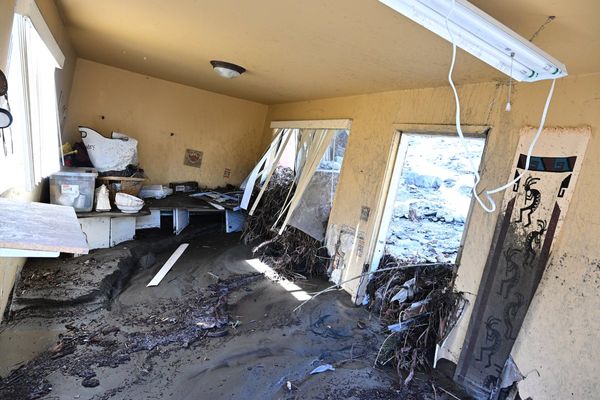
The Rock of Cashel, a medieval stronghold that once served as the seat of Ireland’s kings, is undeniably magnificent. Perched high on an outcrop overlooking lush Tipperary farmland, its round towers, high crosses and 13th-century Gothic cathedral attract a steady stream of visitors. But it’s not the only Irish castle or abbey to draw large crowds. Even off season, there are long queues for internationally recognised sites such as Bunratty, Clonmacnoise, Glendalough, Dunluce, Blarney and Kylemore. Unesco-designated world heritage site Skellig Michael (famous as Luke Skywalker’s island sanctuary in Star Wars) has limited access, and other ancient buildings have been made into five-star hotels.
But this is a country where a castle or abbey can appear around almost every windswept corner, so there are thousands of off-the-radar places to visit. These sites have equally impressive architecture, and possibly even more intriguing backstories, but a noticeable absence of tour buses and crowds because they haven’t featured on the big or small screen – yet. In most cases, you’ll share the space with just a handful of Hibernophiles. With that in mind, we’ve selected eight of the best lesser-known abbeys and castles in Ireland dating from the seventh to the 19th centuries.
Saints and scholars
Grianán of Aileach, Inishowen, Co Donegal, circa 800
This 23-metre wide, five-metre-high hill fort was, for a period, the stronghold of the Ó Néills, one of Ireland’s most powerful dynasties until the end of the Gaelic order and Brehon Law in 1603. The circular fortress is one of the finest examples of pre-Norman architecture in the country, with 4½-metre-thick dry-stone walls. An entrance passage leads to an arena with tiered stone steps along the perimeter that climb to a series of terraces. Even by today’s standards the building is impressive. Its hilltop location 250 metres above sea level means epic views over hills, valleys and both Lough Swilly and Lough Foyle – where Viking fleets entered the Inishowen peninsula in search of trouble, only to be stripped of their gold by local warriors. The site dates back to much earlier inhabitation more than 3,000 years ago. A holy well behind the fortress is named after Saint Patrick – in the fifth century he reputedly baptised Owen (Eoghan– a local prince who lent his name to the Inishowen peninsula. Afterwards, head along Lough Swilly’s coast and linger at the Railway Tavern, a former station house, for sustenance.
Admission Free, discoverireland.ie
Fore Abbey, Co Westmeath, circa 630AD

The seven wonders of Fore relate to the construction stage of Fore Abbey and strange manifestations in the local landscape, from rivers flowing uphill to the boggy terrain that carried the foundation. These days, it’s hard to imagine that this network of ruins in a remote valley was once a thriving centre of education, home to 300 monks and thousands of students. Best guess has it that this medieval monastic complex was established by St Féichín in 630. He died, along with a good portion of his flock, from yellow fever some years later, which brings us to a first anomaly.
The seventh miracle occurred, apparently, when St Féichín raised a two-tonne stone doorway lintel into place by the power of prayer in the 10th century – when he had been dead some time. Despite the time travel issues, the lintel remains in place to this day. Other idiosyncratic features include a hermit’s cell and a fine cloister arcade built later as part of a Benedictine priory by landlord Hugh De Lacy, who also constructed Trim Castle (a setting for the movie Braveheart) about 20 miles away. A marked trail around Fore covers most of the sights, and it is a remarkably beautiful setting. In Fore village is something else that hasn’t changed in a while – the Seven Wonders Pub.
Admission free, heritageireland.ie/
Chieftains and Normans, 1169-1601
The Rock of Dunamase, Co Laois, 13th century

Rising from the contours of a high outcrop and visible for miles from the plains of Laois, Dunamase’s courtyard walls offered an excellent defence for the most important and impressive palace in the county. Today it’s difficult to see where natural rock ends and the man-made structure begins because the buildings, liked cracked teeth, have almost set into the rocky pedestal and weathered over time. Even the barbican, or entrance, is etched into a ditch, so the place has the air of something that emerged organically over the centuries. Kings of Laois sat here from AD845, until a wave of Viking invasions annihilated that chapter of the rock’s history. It was only when Isabel, daughter of Irish and Norman power couple Aoife MacMurrough and Richard “Strongbow” de Clare, occupied the castle in the early 13th century that the site returned to prominence. Irish Brehon Law, which was stamped out 400 years later under English rule, was progressive in matters of sexuality, divorce and female rights – so property could pass from parent to daughter. Dunamase passed through generations of daughters, just like the castle of Gráinne Mhaol (better known as the pirate queen Grace O’Malley of Co Mayo) in the 16th century. Eventually the Rock of Dunamase was abandoned in the late 14th century and virtually destroyed by Cromwellian troops during a siege in 1650.
Admission free, discoverireland.ie/laois/rock-of-dunamase
Quin Abbey, Quin Village, Co Clare 1402

This abbey (officially a friary but always referred to as an abbey) is in pretty Quin Village, a remote hamlet lost in a maze of country lanes. A three-arch bridge and narrow streets curve around the abbey ruin, church and a crumbling chapel, as if to keep watch on the comings and goings along the meadow path to the abbey. The trail closely follows the gushing Rine River through bumpy terrain, where an ancient town settlement has lain buried beneath the tufts of grass for centuries. The abbey started life in 1278 as a giant fortress, built by Thomas de Clare. He was an Anglo Norman peer who spectacularly failed to subdue the local chieftains – decades before, his castle was almost completely razed by the O’Brien clan.
The castle’s round battlements and sturdy walls form part of the 15th-century McNamara Franciscan Abbey, and ooze history. To the right of the nave is a transept with the 19th-century grave of Fireball McNamara, the last McNamara chieftain and hell-raising sidekick of politician and Catholic emancipation leader Daniel O’Connell. Etched on to the scorched south wall of the chancel is the shape of a crucifix desecrated by Cromwellian forces. Just by the neat, perfectly formed cloister are the vaults of the Butlers or Lord Dunboyne dynasty. They were a strand of a powerful family who lived in nearby Knappogue Castle – while in another vault lie the notorious Blood clan from Ballykilty Manor, connected to the Tower of London crown jewel thief. The Abbey Tavern across from the friary is the place to raise a glass to the complicated past.
Admission free, visiteastclare.ie
The darkest centuries, 1602 to 1916
Parke’s Castle, Kilmore, Co Leitrim, 1635

Disneyesque Parke’s Castle, with its neat cobbled courtyard, was started in the aftermath of the bloodbath that was the Battle of Kinsale in 1601 – heralding centuries of English domination. One of the first casualties of that subjugation was Dónal Cam O’Sullivan, the last powerful king or chieftain of south-west Ireland. After the fall of his Dunboy Castle on Beara peninsula in 1602, English crown forces, under the command of Sir George Carew, tossed 300 of Donal’s most vulnerable kinsfolk into the swirling ocean from a rocky headland on nearby Dursey Island. By New Year’s Eve 1602, Dónal had gathered 1,000 survivors and was heading for refuge at Brian Óg O’Rourke’s castle in Leitrim, more than 200 miles north. Only 35 completed the trek due to harsh conditions. Soon Brian Óg was also on the run from crown forces for harbouring renegade Spanish and Irish Catholics loyal to the powerful chieftain Hugh O’Neill, in Tyrone.
The final death knell for the old Gaelic order came with the flight of the earls, in 1607. The days of O’Rourke’s chieftainship in Co Leitrim had truly ended as the gleaming white Parke’s Castle was constructed from the rubble of O’Rourke’s keep on the shores of Lough Gill. It almost embodied the changing of the old order with a new breed of leader and landlord in Ireland: the planters from Great Britain. The twist in the tale is that Kent native Robert Parke, who built the beautiful turreted pale edifice that’s almost stencilled against the dark lake waters late in the evening had a far better relationship with the local Irish community than he did with other planters.
Admission €5, leitrimtourism.com/heritage/parkes-castle
King John’s Castle, Limerick City, circa 1212

One of the world’s best-preserved Norman fortresses, King John’s Castle has thick walls and sturdy battlements that define Limerick City’s westerly river contour. It replaced an earlier Viking settlement, yet if there’s any building to symbolise the 17th-century end of the Williamite War in Ireland and the subsequent wholesale oppression of Irish Catholics, it’s this place. On 3 October 1691, Irish Jacobite leader Patrick Sarsfield conceded defeat of his army to Williamite forces from his base here. The surrender was relatively amicable compared with other bloodthirsty conquests and so Sarsfield reached and signed an agreement for withdrawal on a boulder by the castle – which was called the Treaty Stone. Sarsfield gathered his 10,000 troops in an evacuation known as the Flight of The Wild Geese – and they flew off from King John’s Castle to France, never to return. In exchange for exile, Sarsfield was promised protection of the Catholics that remained in Ireland. However, by 1695 they had lost their basic civil rights under penal laws. The Treaty Stone now stares accusingly at the castle from across the river and the walls of the fortress still bear the scars of cannonballs, while a statue of Sarsfield and another of the Wild Geese stand on the castle perimeters. A French academic based in Limerick has recently discovered Sarsfield’s remains in Belgium; they will be repatriated to Ireland. After your visit, remain in the moment by visiting Katy Daly’s or JJ Bowles, two pubs that vie for the title of the city’s oldest establishment, both close to the castle.
Admission €13, kingjohnscastle.ie
A new state is born
Thoor Ballylee, Gort, Co Galway circa 1450

Down the narrowest of country roads, just a short distance from Gort in south County Galway, is Thoor Ballylee. It’s a tower house burrowed into hedging by a fast-flowing river, with whitewashed thatched cottages by its side. It took a long time to find its way on to the history pages, but when poet, dramatist and larger-than-life figure of Ireland’s newly formed state William Butler Yeats bought it as his home in 1917, that all changed. It was immortalised as the limestone muse of one the world’s most famous literary figures. From then on it became known as Yeats’s Tower.
Many of Yeats’s life milestones happened here: he became a father, a politician, won the Nobel prize for literature and published poetry collection The Tower. The Winding Stair, which followed in 1933, is named after the moon-shaped stone steps that curve their way to the top of the keep. His friend (and the co-founder of Dublin’s Gaiety theatre) Augusta Gregory lived nearby at Coole Park, where he signed the Autograph Tree along with JM Synge, George Bernard Shaw and Sean O’Casey. Yeats also mounted a plaque on the castle walls for posterity with the words: “I, the poet William Yeats/With old mill boards and sea-green slates/And smithy work from the Gort forge/Restored this tower for my wife George;/And may these characters remain/When all is ruin once again.” While in the area, don’t miss Kilmacduagh, an impressive monastic ruin with the highest round tower in the world, which, some say, leans more acutely than Pisa’s. If you’re staying, drop by for mussels at Moran’s on the Weir.
Admission €7, yeatsthoorballylee.org
Glenstal Abbey, Murroe Village, County Limerick 1839

This hilltop castle is almost within earshot of the thunderous sound of the waterfalls that plunge through the Clare Glens, a red sandstone sylvan gorge that defines the Tipperary and Limerick border. Glenstal, with its eclectic mix of neo-Norman and Irish architecture, was a hare’s whisper from being Áras an Uachtaráin – Ireland’s version of the White House. WT Cosgrave, the first head of government of the fledgling Irish republic, seriously considered it as his seat of power, before settling on Dublin for logistical reasons. Ownership was passed shortly afterward to the Benedictine Order from Charles Barrington, a grieving local philanthropist whose daughter Winifred was accidentally and fatally shot during the Black and Tan war near Glenstal on 14 May 1921. Almost six years to the day later, an entourage arrived in the village of Murroe from Belgium to establish the new monastery. Today, behind the twin sandstone towers and turreted facade is an elite boarding school for boys, while the exquisite grounds feature a working farm. The garden, with its lakes and ancient trees, was planted to look its best in late spring and still blossoms with pink rhododendrons – the flowers that lay by young Winifred while she was laid out in the castle a century earlier. Guests, who include celebrities, can stay overnight (in the guesthouse or in two “God Pods” – self-catering units with a nightly suggested rate of €120) and are welcome to join the community for meals. Day visitors can take a tour (organised in advance for groups), which includes scones in the abbey and attending a mass to hear the monks’ and students’ acclaimed Gregorian chant.
glenstal.com







